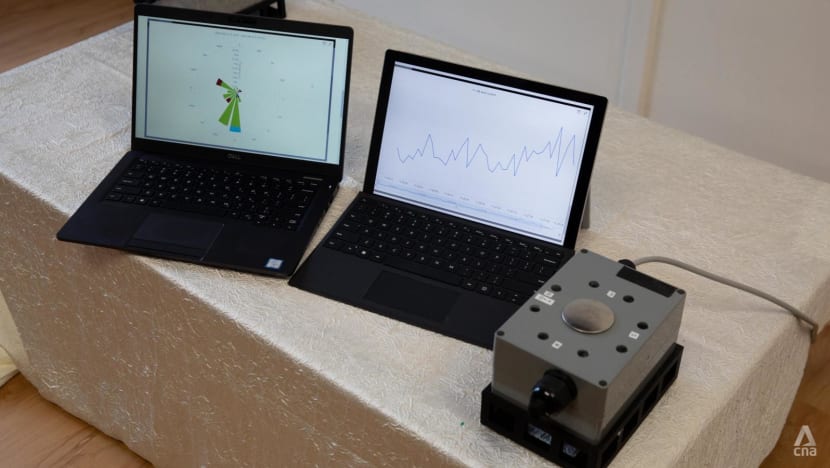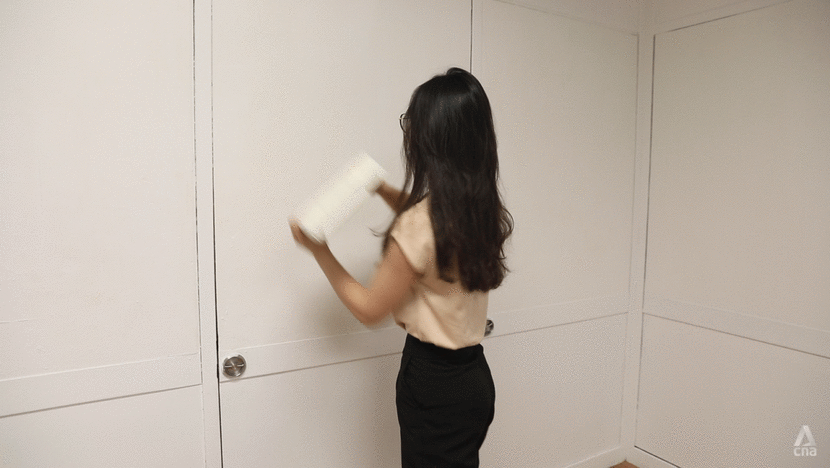New govt unit to investigate severe neighbour disputes, could deploy noise sensors under proposed law
The Community Relations Unit can investigate and take action in severe cases after earlier intervention efforts are exhausted.
The noise sensor and the data it captures in charts during a demonstration on Aug 12, 2024. The charts show the direction and intensity of the noise. (Photo: CNA/Ili Nadhirah Mansor)

Koh Wan Ting
12 Aug 2024 02:45PM (Updated: 12 Aug 2024 04:09PM)
SINGAPORE: A new government unit with the power to investigate severe neighbour noise disputes, including the ability to deploy noise sensors, is expected to operate after a Bill is passed, as part of efforts to bring about resolutions in such disputes, three ministries announced on Monday (Aug 12).
The Community Relations Unit (CRU) can investigate and take action in severe cases of neighbour disputes involving noise and hoarding, the Ministry of Law, the Ministry of Culture, Community and Youth, and the Ministry of National Development said.
The new arm is part of enhancements to the Community Disputes Management Framework (CDMF), which was set up in 2014 to help with neighbour disputes.
Enhancements to the CDMF will be introduced in parliament through the Community Disputes Resolution (Amendment) Bill, which will undergo its first reading later this year.
The three ministries conducted a public consultation and focus group discussions for CDMF from May last year to ask for feedback on community building and neighbour disputes.
They said most respondents expected the government to exercise greater authority to intervene in a minority of "particularly severe" cases. These include those who use noise as a way to disturb their neighbours, with earlier attempts at dialogue and reaching a resolution proving unsuccessful.
ONE-YEAR PILOT STARTING WITH TAMPINES
Mr Yap Yeow Chern, a senior director of operations in the Municipal Services Office (MSO), said that having investigation powers will help the CRU in its work."When we're actually investigating the very small subset of severe cases, we found that sometimes the residents will evade us," he added.
"So in cases where the frontline agencies visit a suspected unit, the noise dies down miraculously, and then when the agencies leave, subsequently, the noise comes back again."
Without investigation powers that compel people to attend interviews or to record a statement, the authorities would be unable to take "the next step", Mr Yap said.
After the Bill is passed, the CRU - which currently has 15 staff members - will be piloted for a year in the Housing Board estates of one to two towns, starting with Tampines. The ministries said Tampines had an "average caseload" compared to other towns.
The authorities will then review the CRU and assess how it can be sustainably scaled up.
Staffed by community relations officers (CROs), the unit will also be supported by auxiliary police officers. CROs will be given investigation and enforcement powers to intervene in severe noise-related disputes.
They will be able to:
- Take statements from involved parties
- Enter a residence to gather evidence - with the consent of the owner, occupier, or with approval from the director-general of community relations
- Issue a mediation direction to require the neighbours concerned to attend mediation, if the case is found suitable for mediation
- Issue advisories, warnings or abatement orders that require the individual to take reasonable steps to stop the noise nuisance
- Require the removal of the nuisance-causing object, after sufficient warning and with authorisation from the director-general
"I need to emphasise that the CRU is only a part of, and not a substitute for, neighbors building bonds, neighbours coming together early, neighbours talking frequently, as well as community norms and mediation," said Mr Yap.
"The CRU therefore must not function as the first resort. Having the government step in all the time to resolve neighbor disputes is neither sustainable, nor is it desirable for our community spirit."
NOISE SENSORS TO BE DEPLOYED
Mr Yap said that feedback on neighbour noise rose sharply during the COVID-19 pandemic and has not returned to pre-pandemic levels.The authorities received 2,160 cases of such feedback per month in the first half of this year. However, most disputes are resolved with "good neighbourly communication and informal mediation", Mr Yap noted.
Around 90 per cent of cases are resolved with earlier intervention, with the remaining 10 per cent proving more more challenging. Only a portion of these challenging cases will require noise sensors, such as if the source of commotion is disputed.
The CRU will use noise sensors to collect objective evidence on the direction, timing and intensity of the noise.

"This addresses the current gap where sound recordings made by complainants are often not useful for the purposes of determining the volume (as playback can be distorted) or source of noise," the three ministries said in a press release.
The sensor is optional and will only be located in a residence with the consent of the occupier or owner. It can also be deployed in shared areas, like the common corridors, with the consent of managing agents.
Mr Yap said that noise sensors will only be placed in the complainants' homes, rather than the residence where the noise comes from.
"The reason why we do that is because if you are a complainant, we want to capture your lived experience, how bad is the sound affecting you?" he added.
"If I deploy it in the nuisance-maker's (house), it doesn't tell me how badly the (complainant) is affected. It can tell me how loud the guy is ... But that does not tell me whether everyone else is affected."
When the noise sensor is deployed in common areas, a sign will be placed to inform the public of its function.
HOW THE NOISE SENSOR WORKS
The ministries gave a demonstration of how the device picks up sounds.Eight microphones located on the sensor can pinpoint the direction of the noise, while a non-directional microphone detects the intensity of the noise.
After the device records the sound, the recording will be sent to Singapore-based servers for data processing in the form of two charts.

One chart, in the form of a line graph, will depict the intensity of the noise above an ambient baseline over time.
The other chart, which resembles a pie chart, will detail the direction of the noise through the eight directional microphones. The chart will also capture the level of noise produced.
To safeguard privacy, the recording will then be expunged immediately, and no person will have access to the recording and its content.
The sensor will be deployed between three to seven days.
Noise sensors will complement officers' efforts after initial investigations have narrowed down its source and neighbours have provided their feedback, and have had the opportunity to resolve the issue amicably.
COMPULSORY MEDIATION
As part of enhancement, the authorities will also encourage greater use of community mediation to resolve neighbour disputes at an early stage.Authorised agencies may direct parties to attend mediation at the Community Mediation Centre (CMC) to resolve neighbour disputes.
The CMC has also set up more satellite mediation venues at selected community clubs and Service SG centres to improve access to mediation.
Currently, about 80 per cent of voluntary mediation cases mediated by the CMC are successfully settled, according to the ministries. However, less than 30 per cent of total cases registered actually proceed to mediation because one party refuses to.
"With a bit of a nudge, we can encourage more people to go for mediation, which is why a key plank of the amendments is mandatory mediation or directed mediation," Mr Yap said.
Agencies such as the CRU and CMC will be empowered to direct disputing neighbours to attend mediation at the CMC by issuing a mediation direction.
The mediation direction framework will be piloted together with the CRU to resolve suitable disputes over noise.
ENHANCING POWERS OF CDRT
The Community Disputes Resolution Tribunals (CDRT), which is the avenue of last resort for complainants after mediation and other earlier interventions have failed, will have new powers to make certain orders for quicker and more effective resolution of cases.CRU's fact-finding process will be integrated with the CDRT process, empowering the tribunal to make interim orders and mandatory treatment orders. A mandatory treatment order directs a person suffering from certain treatable psychiatric conditions to undergo psychiatric treatment.
For severe hoarding cases, the CRU can apply for a CDRT order to declutter a residential unit.
This will come after the tribunal is satisfied that the hoarding has caused unreasonable interference to the hoarder’s neighbour and the hoarder has not complied with an initial CDRT order to declutter.
The ministries stressed that regular communication between neighbours should come first.
"Good neighbours should come together early and often. Such ties go a long way to building social capital that can weather everyday frictions," the ministries said.
"For the minority of cases that cannot be resolved via community self-help, the enhanced CDMF will provide a wider range of options to facilitate effective resolution of neighbour disputes."

